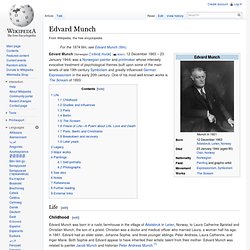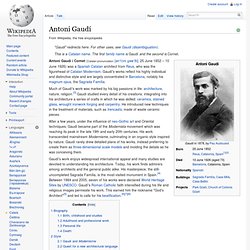

ROA Creates A Giant Lanticular in London - StumbleUpon. Salvador Dali. Edvard Munch. Edvard Munch (Norwegian: [ˈɛdvɑʈ muŋk] ( Life[edit] Childhood[edit] Edvard Munch was born in a rustic farmhouse in the village of Ådalsbruk in Løten, Norway, to Laura Catherine Bjølstad and Christian Munch, the son of a priest.

Christian was a doctor and medical officer who married Laura, a woman half his age, in 1861. Edvard had an elder sister, Johanne Sophie, and three younger siblings: Peter Andreas, Laura Catherine, and Inger Marie. The family moved to Christiania (now Oslo) in 1864 when Christian Munch was appointed medical officer at Akershus Fortress. Christian's positive behavior toward his children was overshadowed by his morbid pietism. Christian Munch's military pay was very low, and his attempts at developing a private side practice failed, keeping his family in perennial poverty.[2] They moved frequently from one sordid flat to another. Studies and influences[edit] Self Portrait with Skeleton Arm, 1895 Paris[edit] Berlin[edit] Edvard Munch 1902 The Scream[edit] Antoni Gaudí. Antoni Gaudí i Cornet (Catalan pronunciation: [ənˈtɔni ɣəwˈði]; 25 June 1852 – 10 June 1926) was a Spanish Catalan architect from Reus, who was the figurehead of Catalan Modernism.

Gaudí's works reflect his highly individual and distinctive style and are largely concentrated in Barcelona, notably his magnum opus, the Sagrada Família. Much of Gaudí's work was marked by his big passions in life: architecture, nature, religion.[3] Gaudí studied every detail of his creations, integrating into his architecture a series of crafts in which he was skilled: ceramics, stained glass, wrought ironwork forging and carpentry. He introduced new techniques in the treatment of materials, such as trencadís, made of waste ceramic pieces. After a few years, under the influence of neo-Gothic art and Oriental techniques, Gaudí became part of the Modernista movement which was reaching its peak in the late 19th and early 20th centuries.
Biography[edit] Birth, childhood and studies[edit] Personal life[edit] Expressionism. Expressionism was a modernist movement, initially in poetry and painting, originating in Germany at the beginning of the 20th century.

Its typical trait is to present the world solely from a subjective perspective, distorting it radically for emotional effect in order to evoke moods or ideas.[1][2] Expressionist artists sought to express meaning[3] or emotional experience rather than physical reality.[3][4] Origin of the term[edit] In 1905, a group of four German artists, led by Ernst Ludwig Kirchner, formed Die Brücke (the Bridge) in the city of Dresden. This was arguably the founding organization for the German Expressionist movement, though they did not use the word itself. A few years later, in 1911, a like-minded group of young artists formed Der Blaue Reiter (The Blue Rider) in Munich. "View of Toledo" by El Greco, 1595/1610 has been indicated to have a particularly striking resemblance to 20th-century expressionism.
Expressionist-Visual artists[edit] Jean-Michel Basquiat : The Radiant Child. Jean Michel Basquiat Interview New York (1980) Basquiat. Doze Green @ Jonathan Le Vine Galery.